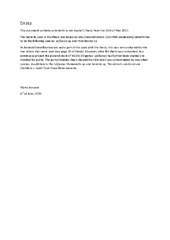| dc.contributor.advisor | Andersen, Jeanette Hammer | |
| dc.contributor.advisor | Hansen, Espen | |
| dc.contributor.advisor | Kristoffersen, Venke | |
| dc.contributor.advisor | Hansen, Kine Østnes | |
| dc.contributor.author | Jenssen, Marte | |
| dc.date.accessioned | 2018-01-11T13:27:25Z | |
| dc.date.available | 2018-01-11T13:27:25Z | |
| dc.date.issued | 2017-05-15 | |
| dc.description.abstract | The number of compounds being isolated from the marine environment is increasing, and there is a great potential for discovering new marine derived drug candidates. Improved collection techniques has strengthened bioprospecting on a wider diversity of marine microorganisms. The focus on microorganisms has led to the realisation that many of the natural products originally isolated from macroorganisms, are metabolic products produced by their associated microorganisms. This, and the fact that most marketed antimicrobial drugs originate from microorganisms, motivated the work conducted as part of this thesis.
In this study, two Arctic marine bacteria of the genus Leifsonia and Polaribacter were studied. The “One Strain-Many Compounds” (OSMAC) approach was utilised when cultivating the bacteria, in an attempt to trigger the bacteria into activating different metabolic pathways and producing compounds with interesting chemistry and bioactivity. Seven different cultivation treatments were used, varying different parameters e.g. media composition and temperature. The secondary metabolites secreted by the cultivated bacteria were harvested, extracted and prefractionated. The fractions were screened for antibacterial activity, inhibition of biofilm formation and anticancer activity. The bioactivity screening resulted in eight active fractions. Dereplication of the active fractions gave several candidates that could be responsible for the observed bioactivity. The results from this thesis give a valuable starting point for further research on cultivation of Arctic marine bacteria, with the purpose of producing bioactive secondary metabolites. | en_US |
| dc.identifier.uri | https://hdl.handle.net/10037/11967 | |
| dc.language.iso | eng | en_US |
| dc.publisher | UiT The Arctic University of Norway | en_US |
| dc.publisher | UiT Norges arktiske universitet | en_US |
| dc.rights.accessRights | openAccess | en_US |
| dc.rights.holder | Copyright 2017 The Author(s) | |
| dc.rights.uri | https://creativecommons.org/licenses/by-nc-sa/3.0 | en_US |
| dc.rights | Attribution-NonCommercial-ShareAlike 3.0 Unported (CC BY-NC-SA 3.0) | en_US |
| dc.subject.courseID | BIO-3901 | |
| dc.subject | VDP::Technology: 500::Biotechnology: 590 | en_US |
| dc.subject | VDP::Teknologi: 500::Bioteknologi: 590 | en_US |
| dc.title | Exploring the potential of two arctic marine bacteria for the production of bioactive metabolites | en_US |
| dc.type | Master thesis | en_US |
| dc.type | Mastergradsoppgave | en_US |


 English
English norsk
norsk

